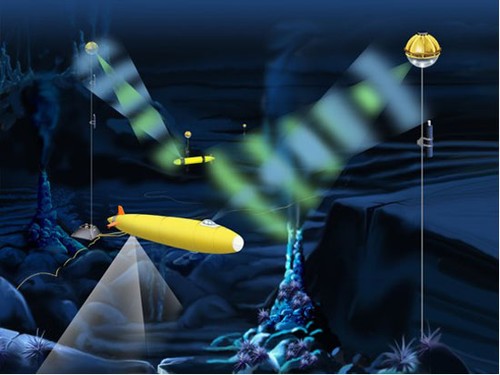Optical system promises to revolutionize undersea communications
by Woods Hole Oceanographic Institution on 27 Mar 2010

Artist’s conception of how the optical modem could function at a deep ocean cabled observatory. Autonomous underwater vehicles (AUVs) collect sonar images (downward bands of light) and other data at a hydrothermal vent site and transmit the data through an optical modem to receivers stationed on moorings in the ocean. The moorings are connected to a cabled observatory, and the data are sent back to scientists on shore. Scientists, in turn, can send new instructions to the AUVs via the optical modem as well. (E. Paul Oberlander, Woods Hole Oceanographic Institution) Woods Hole Oceanographic Institution (WHOI)
http://www.whoi.edu/
In a technological advance that its developers are likening to the cell phone and wireless Internet access, Woods Hole Oceanographic Institution (WHOI) scientists and engineers have devised an undersea optical communications system that—complemented by acoustics—enables a virtual revolution in high-speed undersea data collection and transmission.
Along with the 'transfer [of] real-time video from un-tethered [submerged] vehicles' up to support vessels on the surface, 'this combination of capabilities will make it possible to operate self-powered ROVs [remotely operate vehicles] from surface vessels without requiring a physical connection to the ROV,' says WHOI Senior Engineer Norman E. Farr, who led the research team. This will not only represent a significant technological step forward, but also promises to reduce costs and simplify operations, they say.
Thei report was presented Feb. 23 at the 2010 Ocean Sciences Meeting in Portland, Oregan.
Compared to communication in the air, communicating underwater is severely limited because water is essentially opaque to electromagnetic radiation except in the visible band. Even then, light penetrates only a few hundred meters in the clearest waters; less in sediment-laden or highly populated waters.
Consequently, acoustic techniques were developed, and are now the predominant mode of underwater communications between ships and smaller, autonomous and robotic vehicles. However, acoustic systems—though capable of long-range communication—transmit data at limited speeds and delayed delivery rates due to the relatively slow speed of sound in water.
Now, Farr and his WHOI team have developed an optical communication system that complements and integrates with existing acoustic systems to enable data rates of up to 10-to-20 megabits per second over a range of 100 meters using relatively low battery power with small, inexpensive transmitters and receivers.
The advance will allow near-instant data transfer and real-time video from un-tethered ROVs and autonomous underwater vehicles (AUVs) outfitted with sensors, cameras and other data-collecting devices to surface ships or laboratories, which would require only a standard UNOLS cable dangling below the surface for the relaying of data.
This would represent a significant advance, Farr says, in undersea investigations of anything from the acidity of water to indentifying marine life to observing erupting vents and seafloor slides to measuring numerous ocean properties. In addition, the optical system would enable direct maneuvering of the vehicle by a human.
He likens optical/acoustic system possibilities to the world opened up by 'your household wi-fi.'
Co-investigator Maurice Tivey of WHOI adds that 'underwater optical communications is akin to the cell phone revolution…wireless communications. The ability to transfer information and data underwater without wires or plugging cables in is a tremendous capability allowing vehicles or ships to communicate with sensors on the seafloor.
'While acoustic communications has been the method of choice in the past it is limited by bandwidth and the bulkiness of transducers,' Tivey says. 'Today, sensors sample at higher rates and can store lots of data and so we need to be able to download that data more efficiently. Optical communications allows us to transfer large data sets, like seismic data or tides or hydrothermal vent variations, in a time-efficient manner.'
When the vehicle goes out of optical range, it will still be within acoustic range, the researchers said.
Because it enables communications without the heavy tether-handling equipment required for an ROV, the optical/acoustic system promises to require smaller, less-expensive ships and fewer personnel to perform undersea missions, Farr said.
This July, WHOI plans the first large-scale deployment of the system at the Juan de Fuca Ridge off shore of the Northwestern United States. The WHOI team will employ the human occupied vehicle (HOV) Alvin to deploy the optical system on a sub sea data concentrator to collect and transmit geophysical data from wellheads situated at the undersea ridge.
Ultimately, Farr says, the system will 'allow us to have vehicles [at specific undersea locations] waiting to respond to an event. It’s a game-changer.'
WHOI scientists collaborating on the research with Farr—who is in the Applied Ocean Physics and Engineering (AOPE) department—and Tivey, chair of the Geology and Geophysics department, are Jonathan Ware, AOPE senior engineer, Clifford Pontbriand, AOPE engineer, and Jim Preisig, AOPE associate scientist.
The work was funded by the National Science Foundation’s Division of Ocean Sciences.
[Sorry, this content could not be displayed]
If you want to link to this article then please use this URL: www.sail-world.com/67859